A Study on the Performance of Soiled Solar Photovoltaic Panels at Different Tilt Angles in Al Seeb, Oman
Abstract
1. Introduction
2. Experimental Setup and Techniques
3. Results and Discussion
3.1. Effect of Daily Cleaning on the Solar Panel
3.2. Effects of Title Angles on the Performance of Photovoltaic Panels
3.3. Effect of Daily Cleaning and Tilt Angle Changes on the Performance of the Solar Panel
4. Conclusions
Author Contributions
Funding
Data Availability Statement
Acknowledgments
Conflicts of Interest
References
- Ebhota, W.S.; Jen, T.-C. Fossil Fuels Environmental Challenges and the Role of Solar Photovoltaic Technology Advances in Fast Tracking Hybrid Renewable Energy System. Int. J. Precis. Eng. Manuf. Green Technol. 2020, 7, 97–117. [Google Scholar] [CrossRef]
- Darwish, Z.A.; Sopian, K.; Fudholi, A. Reduced output of photovoltaic modules due to different types of dust particles. J. Clean. Prod. 2021, 280, 124317. [Google Scholar] [CrossRef]
- Chala, G.T.; Al Alshaikh, S.M.; Sulaiman, S.A. Comparative Study Between Clean, Dusty, and Muddy Photovoltaic Panels in Al Seeb, Oman; Zeng, Y., Wang, S., Eds.; Environmental Science and Technology: Sustainable Development II; Springer Nature: Cham, Switzerland, 2024; pp. 277–287. [Google Scholar]
- Sarver, T.; Al-Qaraghuli, A.; Kazmerski, L.L. A comprehensive review of the impact of dust on the use of solar energy: History, investigations, results, literature, and mitigation approaches. Renew. Sustain. Energy Rev. 2013, 22, 698–733. [Google Scholar] [CrossRef]
- Dincer, I. Renewable energy and sustainable development: A crucial review. Renew. Sustain. Energy Rev. 2000, 4, 157–175. [Google Scholar] [CrossRef]
- Gómez-Calvet, R.; Martínez-Duart, J.M.; Gómez-Calvet, A.R. The 2030 power sector transition in Spain: Too little storage for so many planned solar photovoltaics? Renew. Sustain. Energy Rev. 2023, 174, 113094. [Google Scholar] [CrossRef]
- Dewangan, D.; Ekka, J.P.; Arjunan, T.V. Solar photovoltaic thermal system: A comprehensive review on recent design and development, applications and future prospects in research. Int. J. Ambient Energy 2022, 43, 7247–7271. [Google Scholar] [CrossRef]
- Ebhota, W.; Tabakov, P. Influence of photovoltaic cell technologies and elevated temperature on photovoltaic system performance. Ain Shams Eng. J. 2023, 14, 101984. [Google Scholar] [CrossRef]
- Vodapally, S.N.; Ali, M.H. A Comprehensive Review of Solar Photovoltaic (PV) Technologies, Architecture, and Its Applications to Improved Efficiency. Energies 2023, 16, 319. [Google Scholar] [CrossRef]
- Tyagi, V.V.; Rahim, N.A.A.; Rahim, N.A.; Selvaraj, J.A.L. Progress in solar PV technology: Research and achievement. Renew. Sustain. Energy Rev. 2013, 20, 443–461. [Google Scholar] [CrossRef]
- Spasić, V. Global Solar Power to Cross 200 GW Annual Installation Threshold in 2022. Balkan Green Energy News. Available online: https://balkangreenenergynews.com/global-solar-power-to-cross-200-gw-annual-installation-threshold-in-2022/ (accessed on 17 April 2023).
- Alnasser, T.M.A.; Mahdy, A.M.J.; Abass, K.I.; Chaichan, M.T.; Kazem, H.A. Impact of dust ingredient on photovoltaic performance: An experimental study. Sol. Energy 2020, 195, 651–659. [Google Scholar] [CrossRef]
- Alshebani, M. A critical review of solar energy and dust in Gulf Countries. Int. J. Eng. Res. Appl. 2021, 11, 43–73. [Google Scholar]
- Chanchangi, Y.N.; Ghosh, A.; Sundaram, S.; Mallick, T.K. Dust and PV Performance in Nigeria: A review. Renew. Sustain. Energy Rev. 2020, 121, 109704. [Google Scholar] [CrossRef]
- Yadav, A.; Pillai, S.R.; Singh, N.; Philip, S.A.; Mohanan, V. Preliminary investigation of dust deposition on solar cells. Mater. Today Proc. 2021, 46, 6812–6815. [Google Scholar] [CrossRef]
- Aslam, A.; Ahmed, N.; Qureshi, S.A.; Assadi, M.; Ahmed, N. Advances in solar PV systems; A comprehensive review of PV performance, influencing factors, and mitigation techniques. Energies 2022, 15, 7595. [Google Scholar] [CrossRef]
- Chen, E.Y.-T.; Chen, Y.; Guo, B.; Liang, H. Effects of surface morphological parameters on cleaning efficiency of PV panels. Sol. Energy 2019, 194, 840–847. [Google Scholar] [CrossRef]
- Ndeto, M.P.; Wekesa, D.W.; Njoka, F.; Kinyua, R. Correlating dust deposits with wind speeds and relative humidity to overall performance of crystalline silicon solar cells: An experimental study of Machakos County, Kenya. Sol. Energy 2022, 246, 203–215. [Google Scholar] [CrossRef]
- Moharram, K.A.; Abd-Elhady, M.S.; Kandil, H.A.; El-Sherif, H. Influence of cleaning using water and surfactants on the performance of photovoltaic panels. Energy Convers. Manag. 2013, 68, 266–272. [Google Scholar] [CrossRef]
- Chen, J.; Pan, G.; Ouyang, J.; Ma, J.; Fu, L.; Zhang, L. Study on impacts of dust accumulation and rainfall on PV power reduction in East China. Energy Convers. 2020, 194, 116915. [Google Scholar] [CrossRef]
- Chala, G.T.; Sulaiman, S.A.; Al Alshaikh, S.M. Effects of cooling and interval cleaning on the performance of soiled photovoltaic panels in Muscat, Oman. Results Eng. 2024, 21, 101933. [Google Scholar] [CrossRef]
- Zhao, W.; Lv, Y.; Zhou, Q.; Yan, W. Investigation on particle deposition criterion and dust accumulation impact on solar PV module performance. Energy 2021, 233, 121240. [Google Scholar] [CrossRef]
- Al Siyabi, I.; Al Mayasi, A.; Al Shukaili, A.; Khanna, S. Effect of soiling on solar photovoltaic performance under desert climatic conditions. Energies 2021, 14, 659. [Google Scholar] [CrossRef]
- Chala, G.T.; Al Alshaikh, S.M. Solar Photovoltaic Energy as a Promising Enhanced Share of Clean Energy Sources in the Future—A Comprehensive Review. Energies 2023, 16, 7919. [Google Scholar] [CrossRef]
- Chala, G.T.; Sulaiman, S.A.; Chen, X.; Al Shamsi, S.S. Effects of Nanocoating on the Performance of Photovoltaic Solar Panels in Al Seeb, Oman. Energies 2024, 17, 2871. [Google Scholar] [CrossRef]
- Paudyal, B.R.; Shakya, S.R. Dust accumulation effects on efficiency of solar PV modules for off grid purpose: A case study of Kathmandu. Sol. Energy 2016, 135, 103–110. [Google Scholar] [CrossRef]
- Mohandes, B.M.A.; El-Chaar, L.; Lamont, L.A. Application study of 500 W photovoltaic (PV) system in the UAE. Appl. Sol. Energy 2009, 45, 242–247. [Google Scholar] [CrossRef]
- Gupta, V.; Sharma, M.; Pachauri, R.K.; Babu, K.D. Comprehensive review on effect of dust on solar photovoltaic system and mitigation techniques. Sol. Energy 2019, 191, 596–622. [Google Scholar] [CrossRef]
- Jiang, H.; Lu, L.; Sun, K. Experimental investigation of the impact of airborne dust deposition on the performance of solar photovoltaic (PV) modules. Atmos. Environ. 2011, 45, 4299–4304. [Google Scholar] [CrossRef]
- Li, D.; King, M.; Dooner, M.; Guo, S.; Wang, J. Study on the cleaning and cooling of solar photovoltaic panels using compressed airflow. Sol. Energy 2021, 221, 433–444. [Google Scholar] [CrossRef]
- Aljaghoub, H.; Abumadi, F.; AlMallahi, M.N.; Obaideen, K.; Alami, A.H. Solar PV cleaning techniques contribute to Sustainable Development Goals (SDGs) using Multi-criteria decision-making (MCDM): Assessment and review. Int. J. Thermofluids 2022, 16, 100233. [Google Scholar] [CrossRef]
- Abuzaid, H.; Awad, M.; Shamayleh, A. Impact of dust accumulation on photovoltaic panels: A review paper. Int. J. Sustain. Eng. 2022, 15, 264–285. [Google Scholar] [CrossRef]
- Peterson, J.; Crystal, J.A. Oman. Encyclopedia Britannica. Available online: https://www.britannica.com/place/Oman (accessed on 18 August 2023).
- Bashir, M.A.; Ali, H.M.; Ali, M.; Siddiqui, A.M. An experimental investigation of performance of photovoltaic modules in Pakistan. Therm. Sci. 2015, 19, 525–534. [Google Scholar] [CrossRef]
- El-Nashar, A.M. The effect of dust accumulation on the performance of evacuated tube collectors. Sol. Energy 1994, 53, 105–115. [Google Scholar] [CrossRef]
- Lu, H.; Zhao, W. CFD prediction of dust pollution and impact on an isolated ground-mounted solar photovoltaic system. Renew. Energy 2019, 131, 829–840. [Google Scholar] [CrossRef]
- Babatunde, A.A.; Abbasoglu, S.; Senol, M. Analysis of the impact of dust, tilt angle and orientation on performance of PV Plants. Renew. Sustain. Energy Rev. 2018, 90, 1017–1026. [Google Scholar] [CrossRef]
- Benghanem, M. Optimization of tilt angle for solar panel: Case study for Madinah, Saudi Arabia. Appl. Energy 2011, 88, 1427–1433. [Google Scholar] [CrossRef]
- Ekpenyong, A.I.; Umoren, A.M.; Markson, I. Development of Winter Season Optimal Tilt Angle Model for Fixed Tilted Plane PV Installation in Akwa Ibom State, Nigeria. Math. Softw. Eng. 2017, 3, 67–77. [Google Scholar]
- Lu, H.; Zhao, W. Effects of particle sizes and tilt angles on dust deposition characteristics of a ground-mounted solar photovoltaic system. Appl. Energy 2018, 220, 514–526. [Google Scholar] [CrossRef]
- Hachicha, A.A.; Al-Sawafta, I.; Said, Z. Impact of dust on the performance of solar photovoltaic (PV) systems under United Arab Emirates weather conditions. Renew. Energy 2019, 141, 287–297. [Google Scholar] [CrossRef]
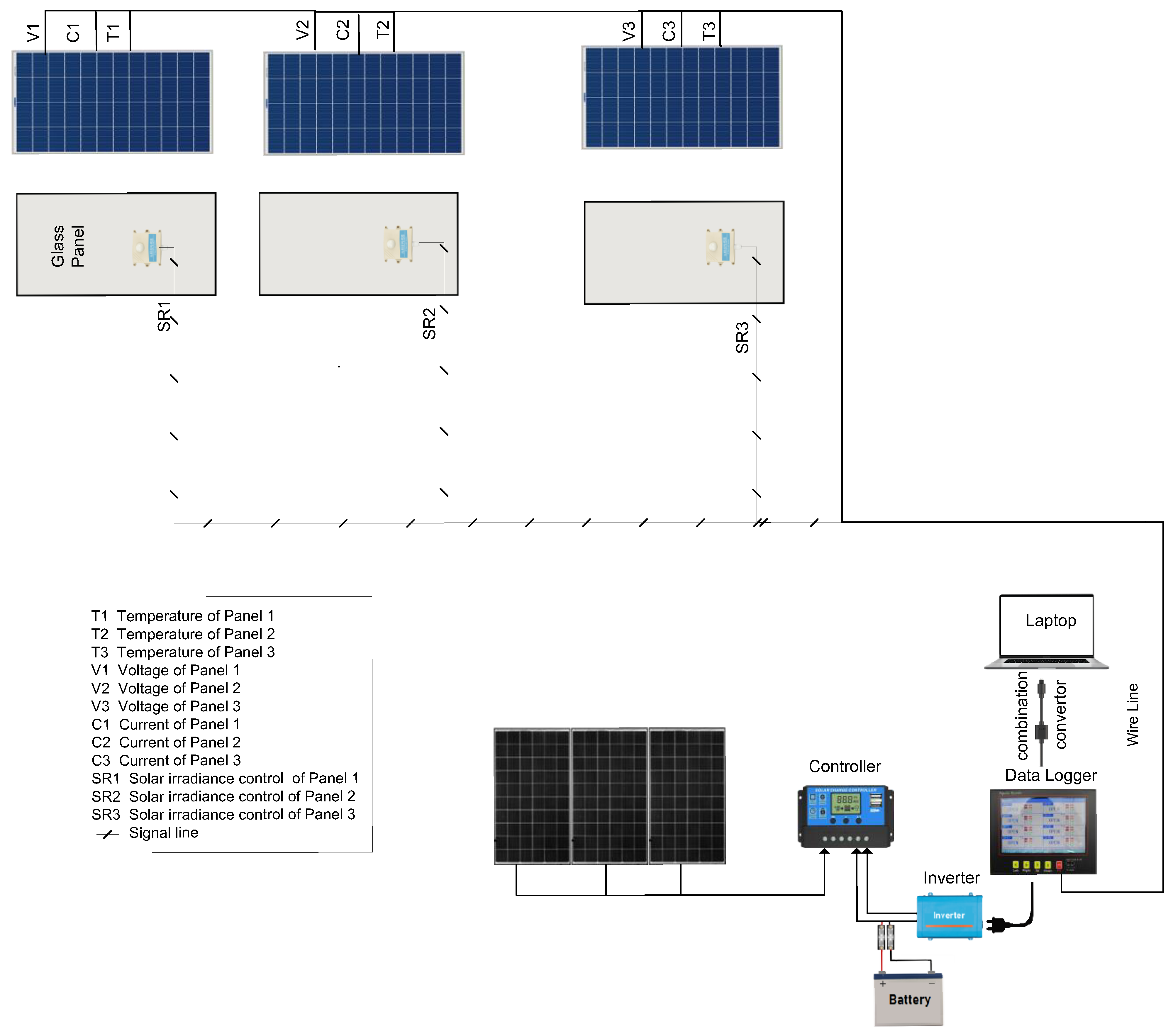

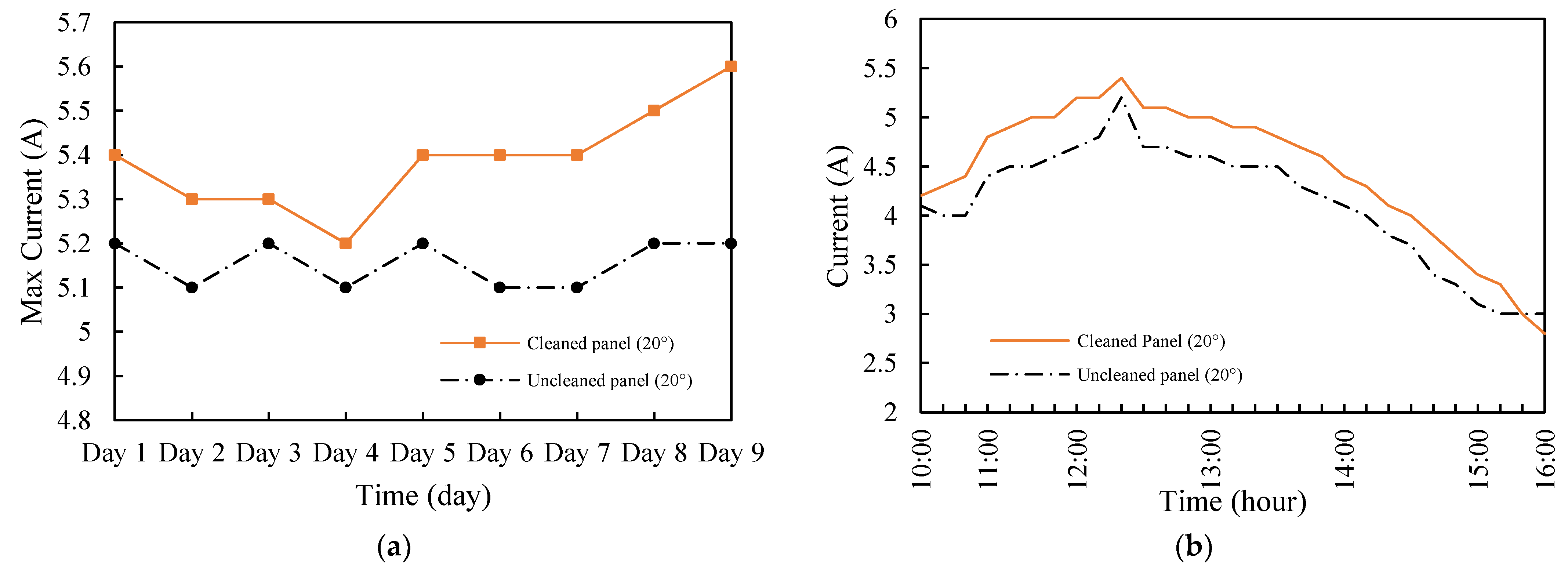
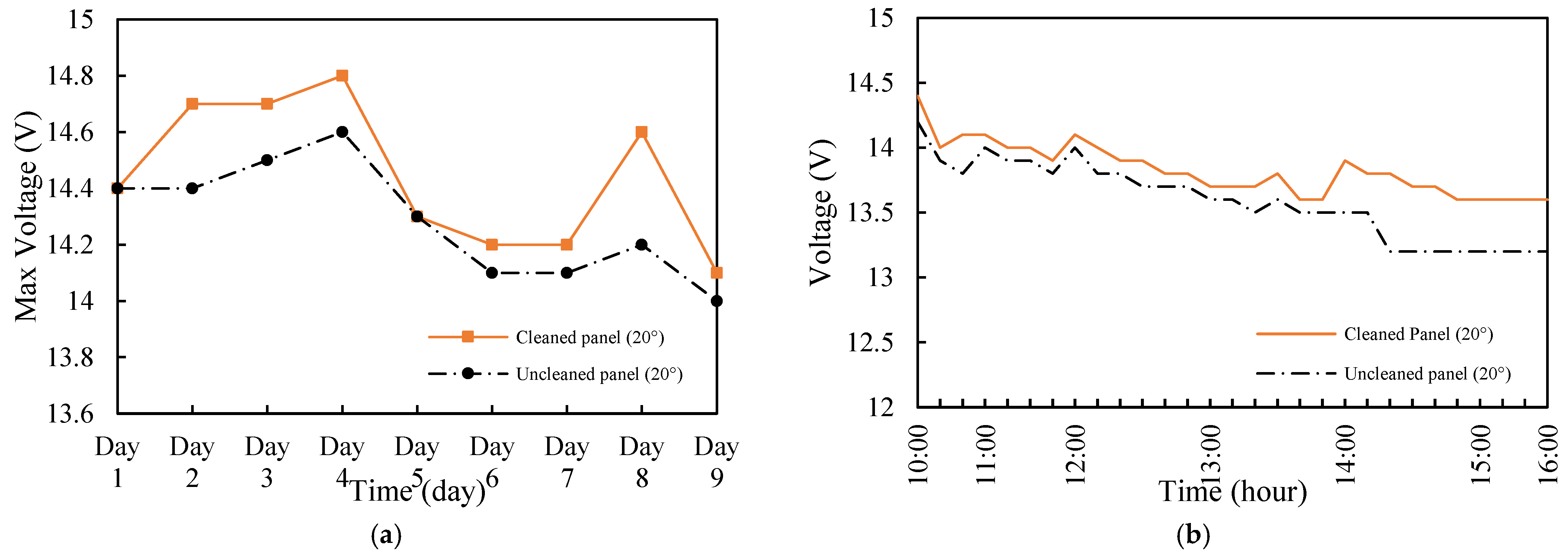
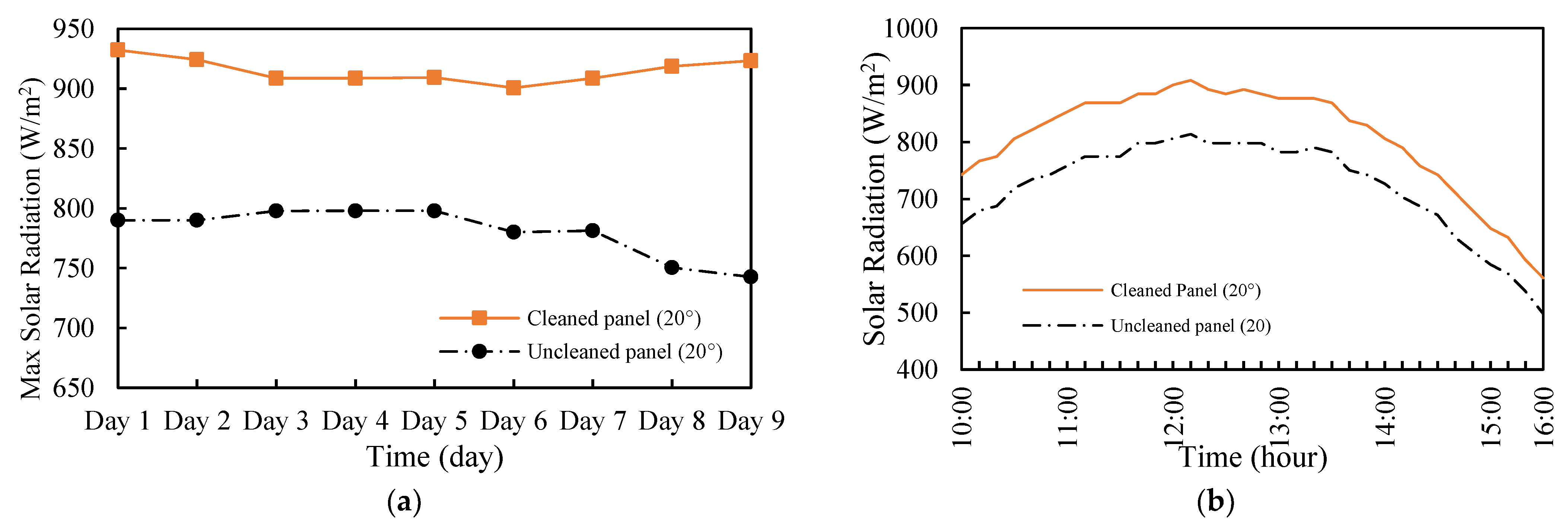
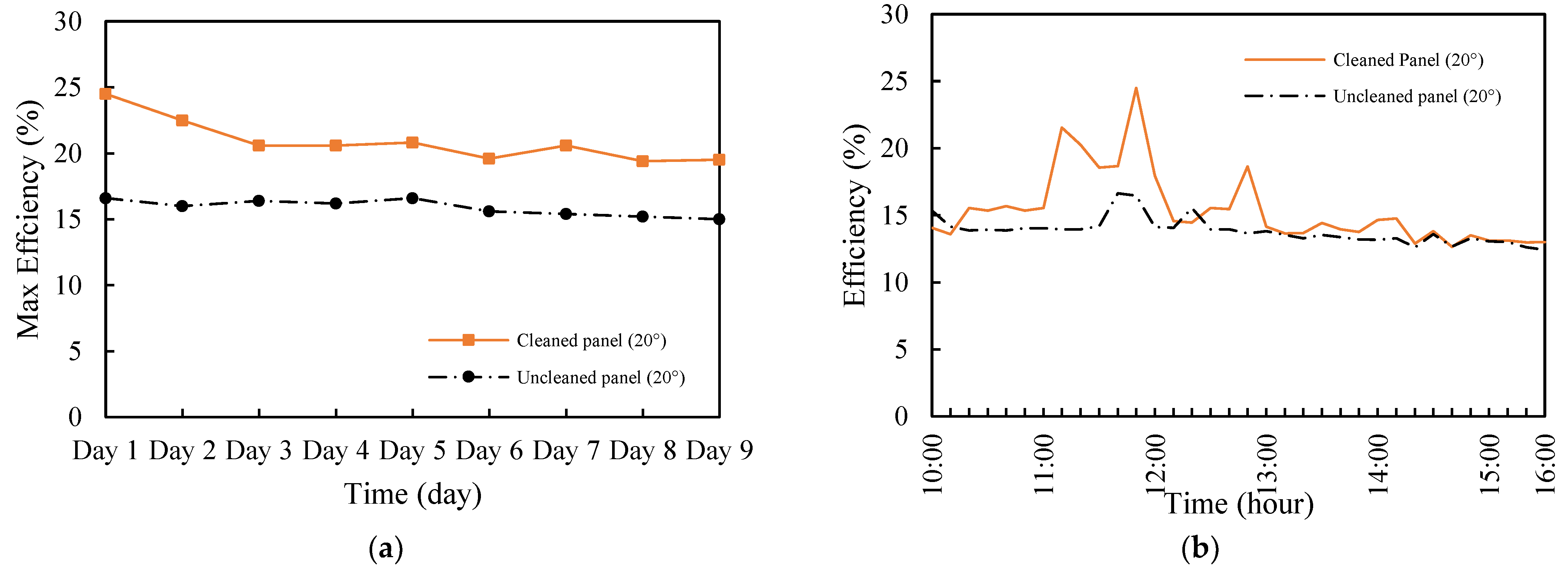
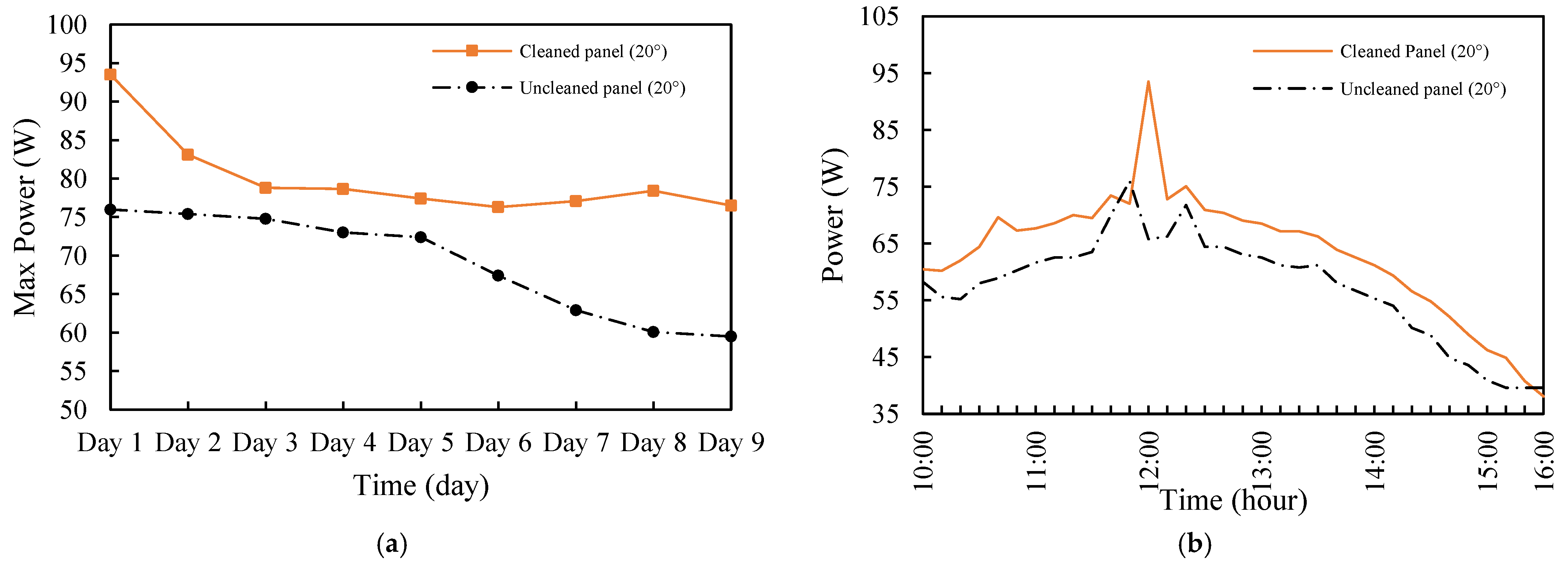



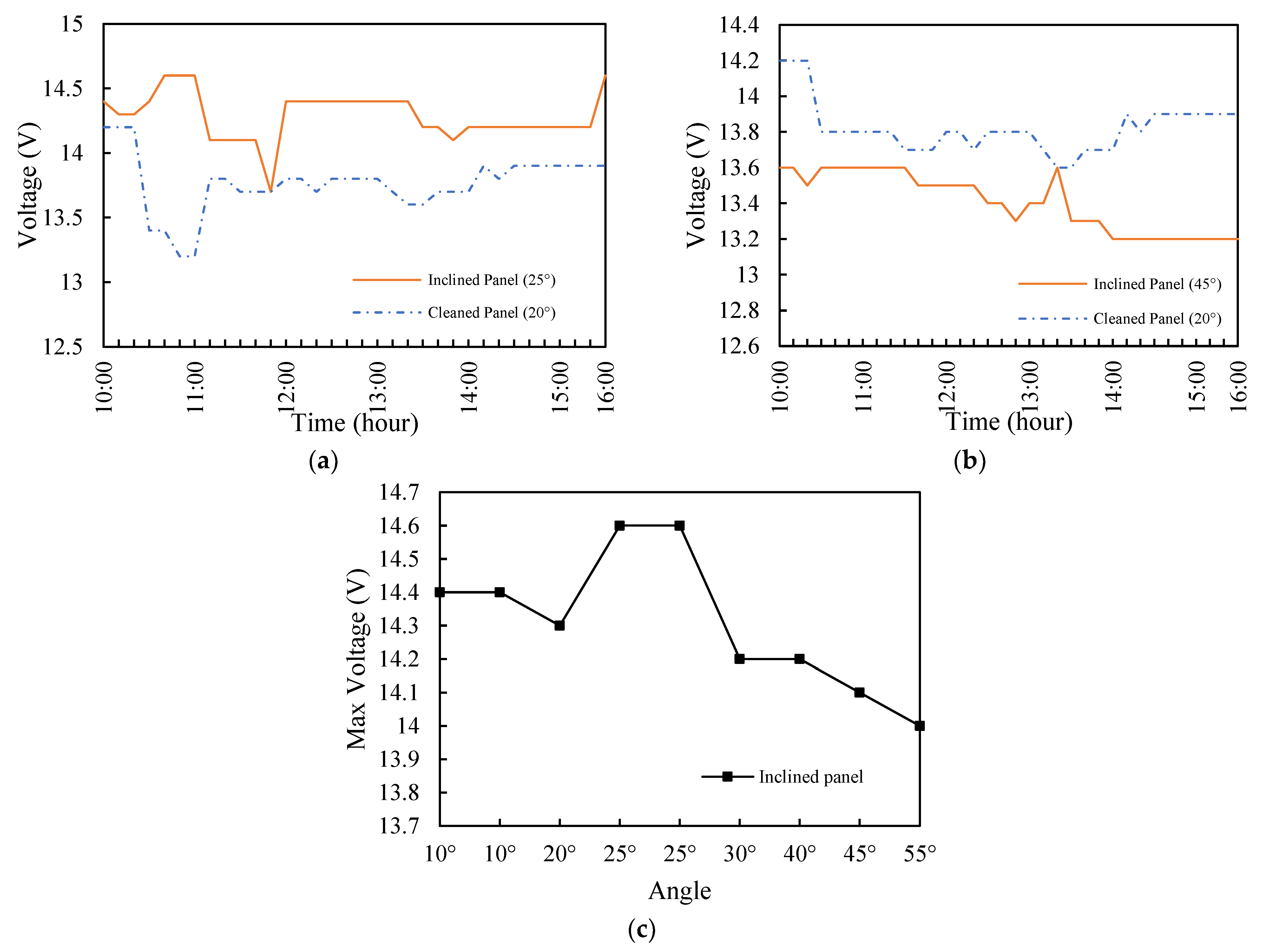
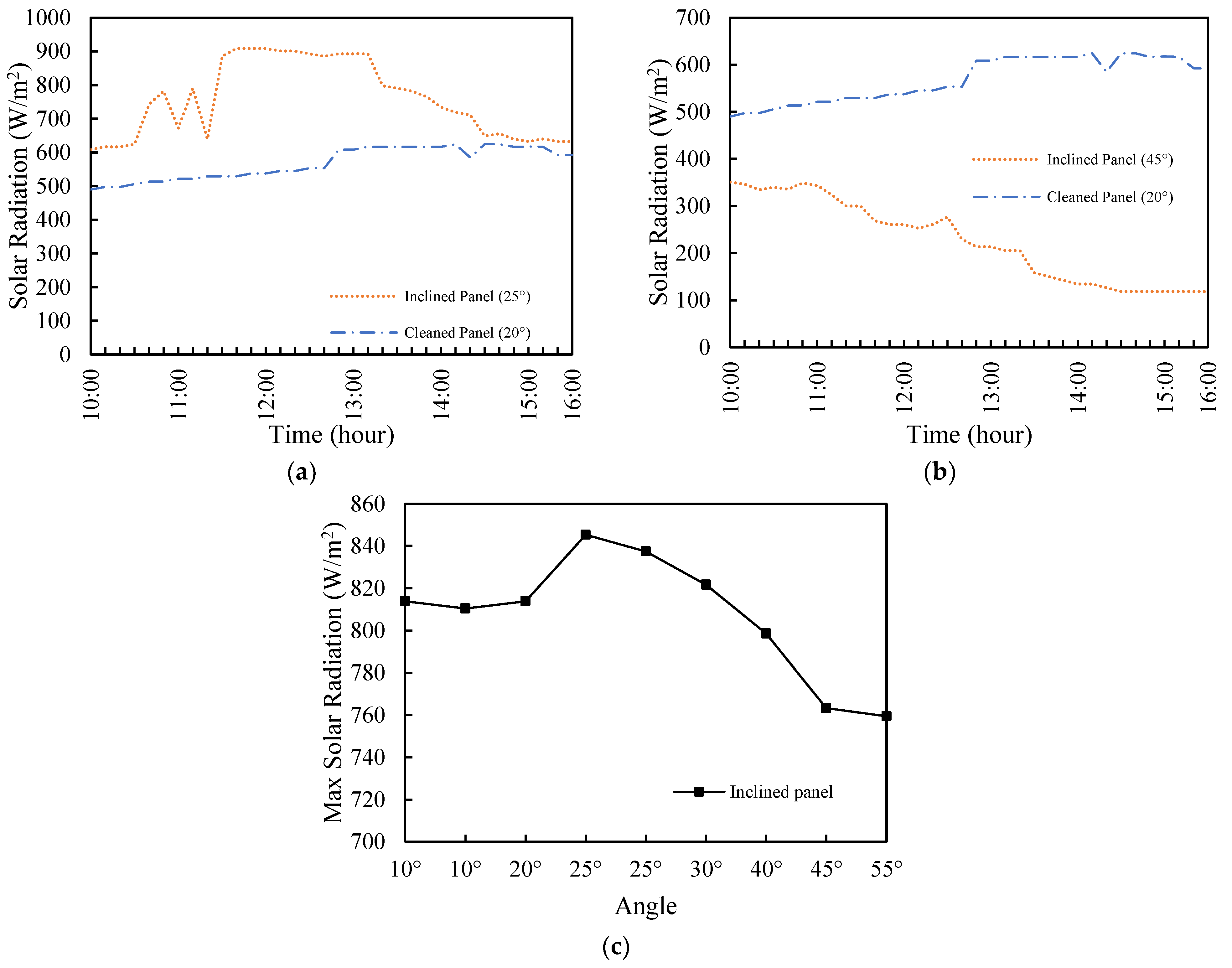
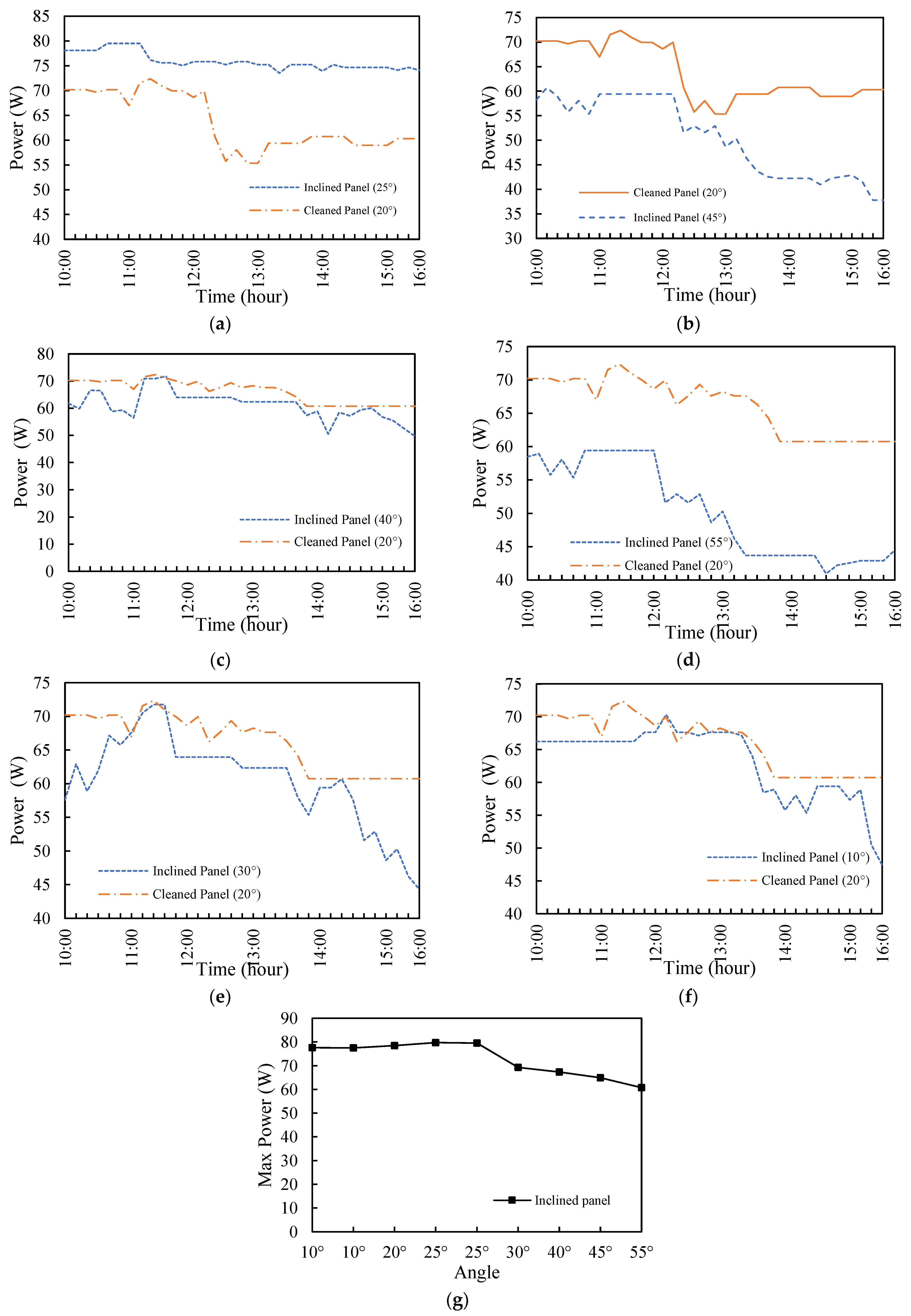

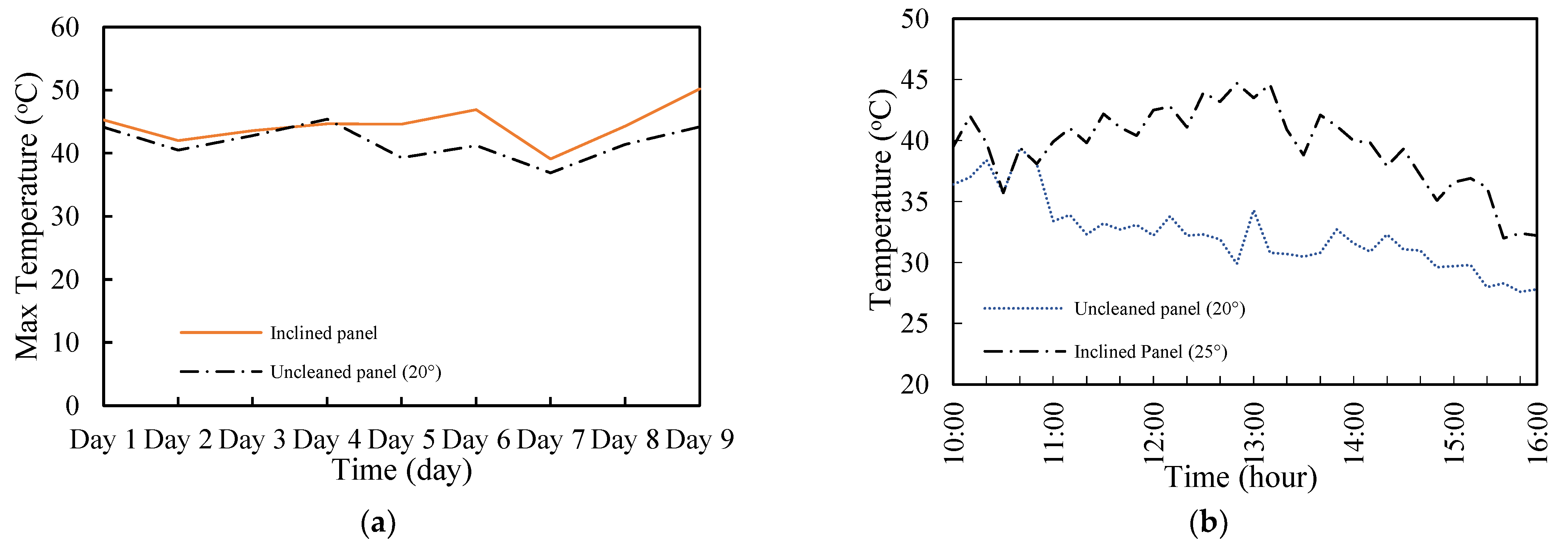
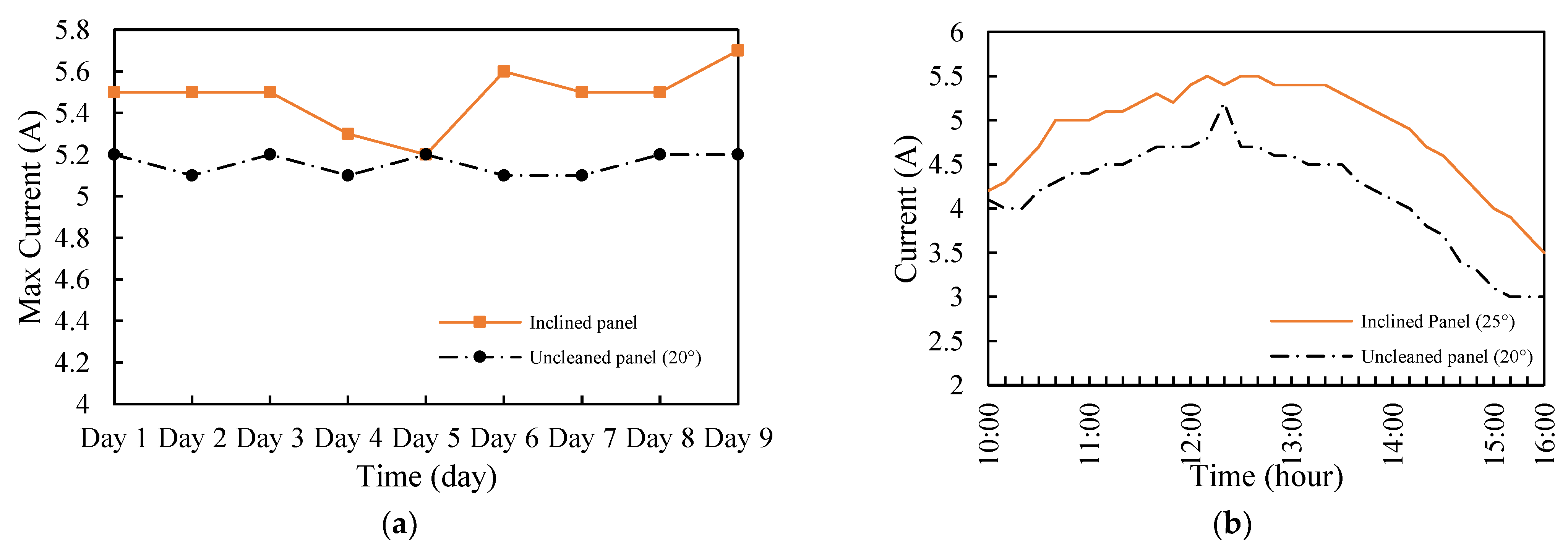
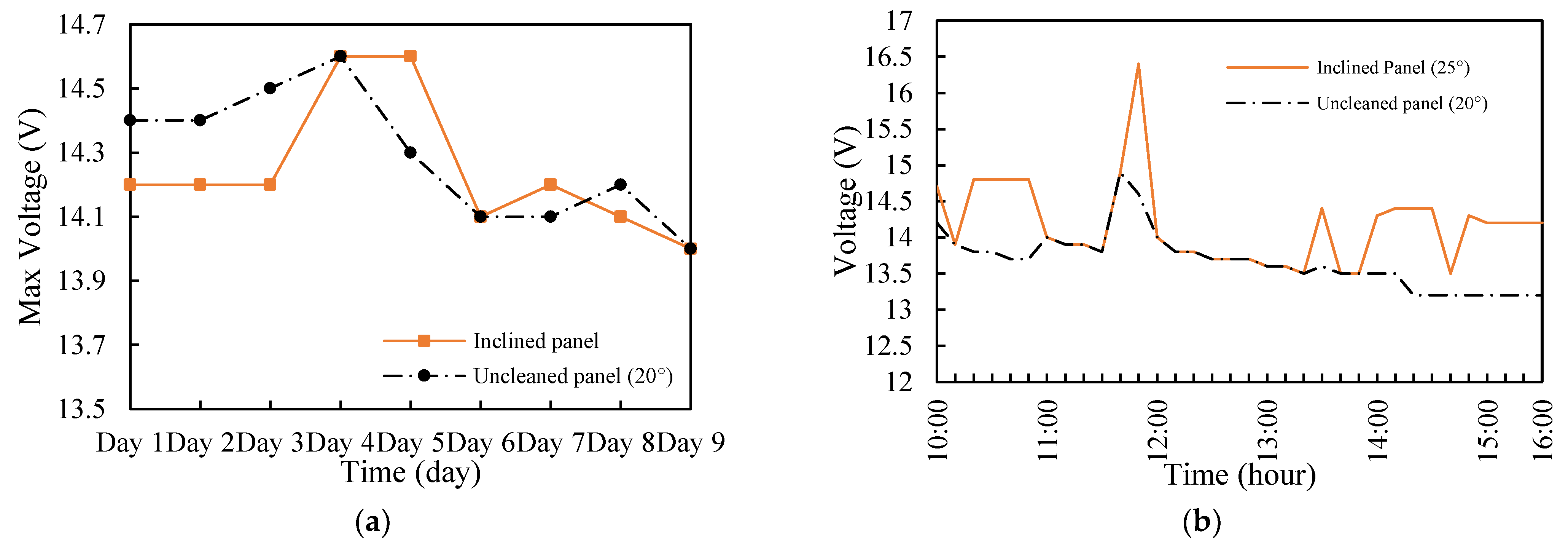
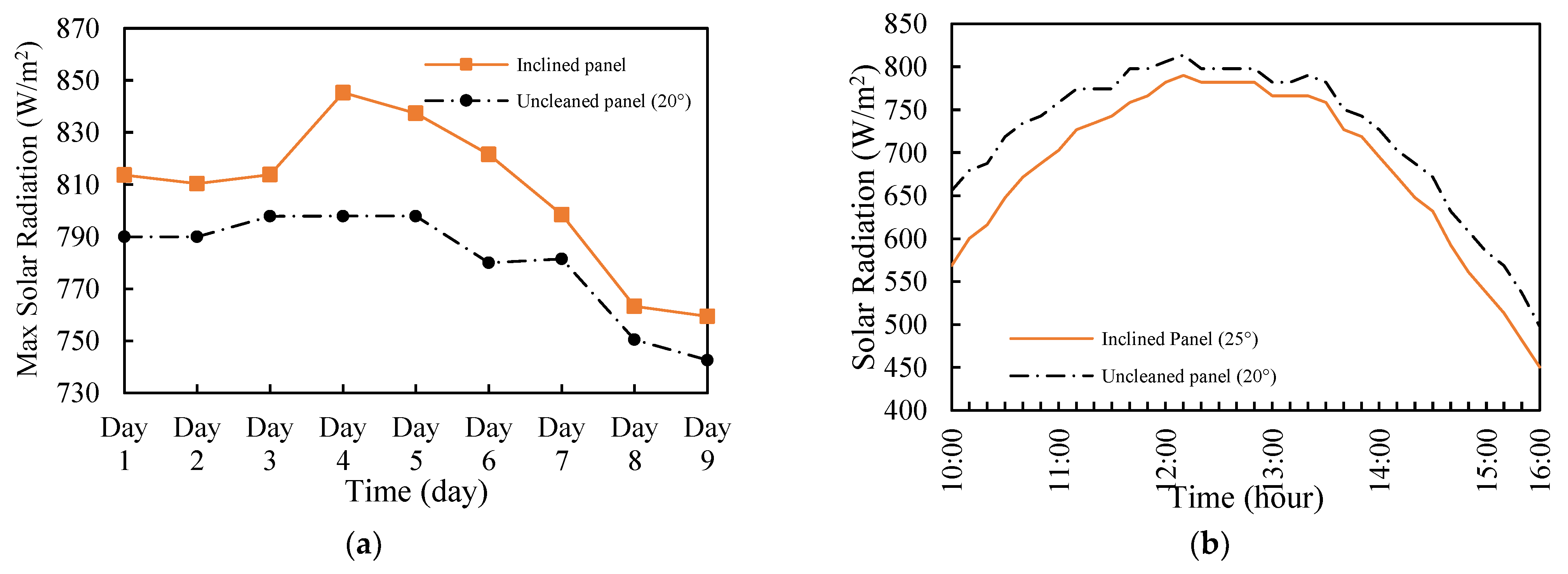


| Rated power (Pmax) at STC | 100 W |
| Maximum power voltage (Vmpp) | 18.4 V |
| Maximum power current (Impp) | 5.43 A |
| Open-circuit voltage (Voc) | 22.6 V |
| Short-circuit current (ISC) | 5.87 A |
Disclaimer/Publisher’s Note: The statements, opinions and data contained in all publications are solely those of the individual author(s) and contributor(s) and not of MDPI and/or the editor(s). MDPI and/or the editor(s) disclaim responsibility for any injury to people or property resulting from any ideas, methods, instructions or products referred to in the content. |
© 2025 by the authors. Licensee MDPI, Basel, Switzerland. This article is an open access article distributed under the terms and conditions of the Creative Commons Attribution (CC BY) license (https://creativecommons.org/licenses/by/4.0/).
Share and Cite
Chala, G.T.; Sulaiman, S.A.; Chen, X. A Study on the Performance of Soiled Solar Photovoltaic Panels at Different Tilt Angles in Al Seeb, Oman. Energies 2025, 18, 301. https://doi.org/10.3390/en18020301
Chala GT, Sulaiman SA, Chen X. A Study on the Performance of Soiled Solar Photovoltaic Panels at Different Tilt Angles in Al Seeb, Oman. Energies. 2025; 18(2):301. https://doi.org/10.3390/en18020301
Chicago/Turabian StyleChala, Girma T., Shaharin A. Sulaiman, and Xuecheng Chen. 2025. "A Study on the Performance of Soiled Solar Photovoltaic Panels at Different Tilt Angles in Al Seeb, Oman" Energies 18, no. 2: 301. https://doi.org/10.3390/en18020301
APA StyleChala, G. T., Sulaiman, S. A., & Chen, X. (2025). A Study on the Performance of Soiled Solar Photovoltaic Panels at Different Tilt Angles in Al Seeb, Oman. Energies, 18(2), 301. https://doi.org/10.3390/en18020301







